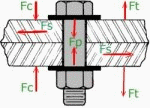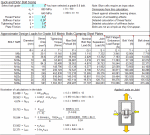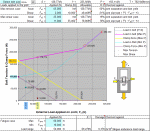Quick and Dirty Bolt Sizing Calculation.xls

Description
The following values are required as inputs to the calculation:
- BOLT GRADE - Enter the two numbers comprise the bolt grade here and the approximate bolt ultimate strength and yield are calculated. The following grades of bolt can be obtained:
grade 3.6
grade 4.6
grade 4.8
grade 5.6
grade 5.8
grade 6.8
grade 8.8 - typical
grade 9.8
grade 10.9 - for high strength duties
grade 12.9
- THREAD FACTOR - The Joint factor determines the amount of bolt pretension achieved for a given tightening torque. It depends upon thread geometry and friction conditions (thread and the nut rotating on the clamped plate). Detailed calculations are possible but you can use the following typical values:
• 0.30 stainless steel bolts
• 0.20 as received bolt (no surface treatment)
• 0.16 cadmium plated bolts
• 0.14 molybdenum-disulphide greased bolts
• 0.12 PTFE lubricated bolts
Low Joint Factor means:
• Low bolt friction (thread, head and nut).
• Higher bolt preload for a given tightening torque.
? = T / (P x ?)
- STIFFNESS FACTOR - When an external load is applied to a pretensioned joint it increases the bolt tension and reduces the contact force between the clampled plates. The stiffness factor determines what proportion of the applied load on the joint increases bolt tension.
Two stiffness terms are important:
• Kb - The stiffness of the tensile loadpath through the bolt.
• Kf - the stiffness of the compressive loadpath through the clamped plates.
The stiffness factor K = Kb/(Kb+Kf).
For a steel bolt clamping steel plates this value is typically 0.24
For a steel bolt clamping Aluminium plates this value is typically 0.41
- TIGHTENING FACTOR - The tightening factor is the ratio of the minimum preload to maximum preload when a batch of bolts are tested. Bolt pretension varies because of a spread in friction values and precision of tightening method. Some typical values are:
0.481 - Operator 'Feel' (accuracy ±35%)
0.600 - Torque Wrench (accuracy ±25%)
0.739 - Angle Torquing or Turn of nut (accuracy ±15%)
0.818 - Load Indicating Washer (accuracy ±10%)
0.905 - Measuring Bolt elongation (accuracy ±5%)
0.980 - Strain Gauges / Ultrasonics (accuracy ±1%)
To assess strength of the bolt a maximum preload is considered but to assess the shear capacity of the joint or the separation load then the minimum preload should be considered.
- PLATE FRICTION - This is the friction between clamped plates in the bolted joint. Never let a joint slip as this could initiate bolt loosening and loss of joint pretension.
0.15 to 0.25 - Steel On Steel - No treatment
0.18 to 0.30 - Steel On Cast Iron - No treatment
0.12 to 0.18 - Steel On Steel - Machined (Degreased)
0.15 to 0.25 - Steel On Cast Iron - Machined (Degreased)
0.48 to 0.55 - Grit - Sandblasted surfaces
The following values are calculated for M6 to M30 bolt sizes: - TIGHTENING TORQUE - The torque applied to the nut of a bolt during assembly of the joint.
Note: Nuts sometime include an anti-loosening feature (nylon inserts or deformable threads). A 'prevailing torque' is required just to rotate the nut on the bolt. The tightening torque equals the total torque applied minus the prevailing torque.
- MAX BOLT PRELOAD - The bolt preload is the amount of tension that is generated in a bolt when the tightening torque is applied. It equals the contact force between the clamped plates. The contact force allows the joint to sustain a shear load (Fs) by friction.
The maximum pretension set by the calculation procedure so that when the separation load is applied to the joint the stress in the bolt is 95% of yield. This is called 'leak before break' and is good practise for all bolted joints.
- NOMINAL BOLT SLIP LOAD - This is the nominal slip load shear loads applied to the joint should be below this value.
Note: tensile axial forces (Fa) applied to the joint will reduce the slip load. The lower calculation table considers simulaneous axial (Fa) and shear loads (Fs) on the joint which accounts for this.
- THE JOINT SEPARATION LOAD - The separation load is the force applied to the joint (Fa) which reduces the contact force between the clamped plates to zero. At this point the joint can sustain no shear load in friction. Never allow joints to separate. Ideally the separation load should always occur just before the bolt yield load.
- BOLT FATIGUE ENDURANCE LOAD RANGE - Provided the axial force range (?Fa) applied on the joint is kept below this value. The joint will withstand 2E6 load cycles according to BS7608.
Note: ?Fa = Famax - Famin
- THE BOLT YIELD LOAD - This is the load required to yield the bolt in direct tension. Good bolted joints should never sparate and therefore never yield.
- THE BOLT SHEAR LOAD - This is the load required to shear through the bolt based on the shear strength of the bolt material. It may only be used to assess an ultimate strength loadcase only. Good bolted joints should carry all shear loads in friction to guard against loosening in service.
For a particular bolt size a joint load diagram is calculated. It requires some additional input: - BOLT SIZE - selected from a drop down list.
- MAX TENSILE LOADCASE - input maximum tension and coincident shear forces applied to the joint for assessment.
- MAX SHEAR LOADCASE - input maximum shear and coincident tensile forces applied to the joint for assessment.
Demand to capacity ratio's are calculated against: - JOINT SEPARATION OR YIELD
- JOINT SLIP
If further consideration is required then proceed to the detailed bolt calculation.
Calculation Preview
Full download access to any calculation is available to users with a paid or awarded subscription (XLC Pro).
Subscriptions are free to contributors to the site, alternatively they can be purchased.
Click here for information on subscriptions.
Comments: 2
×
johndoyle-admin
13 years ago
I have added a new drop down selector box for Separation Factor. Separation Factor is the ratio of the joint tension required to separate a joint to the tension required to yield the bolt.Most people prefer working interactively using the chart so I display the bolt chart immediately after the selection boxes.The detailed calculations can still be found below the bolt chart.



